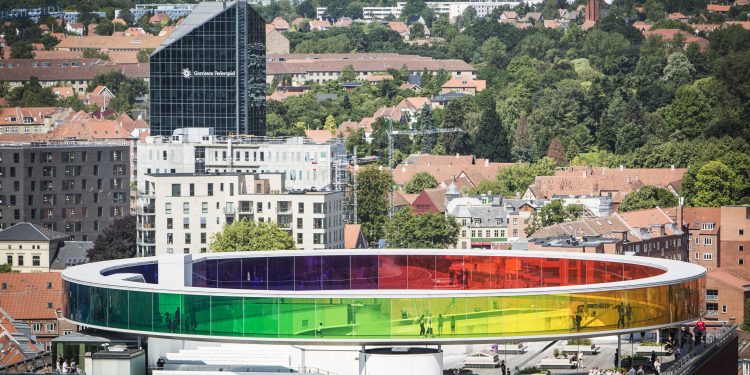An urban translation of the rainbow.
Have you ever known a single work of art with the capacity to change your vision and experience of a whole city? This is what ‘Your Rainbow Panorama’ by Olafur Eliasson at the Aros art museum does for Aarhus.
By Cristina Soler Picture: Aros/Ander Trærup
The article continues below.
In the heart of the charming city of Aarhus, you can find Aros, one of the most significant art museums in Denmark. Both the permanent collection, and the remarkable temporary exhibitions, offer a great opportunity to venture out into the current art world.
As many other art museums, the building of Aros was designed as a simple container for all the artistic creations. In this case, a closed cube of red brick with a vibrant interior of white neutral space, a silent interval from the world where the dialogue between artwork and visitor could be heard.
Any possible connection with the outside reality had to enter the museum through the mind of the visitor. The election of ‘Your Rainbow Panorama’ by Olafur Eliasson to crown the existing building revolutionised the way in which visitors experience Aros.
The article continues below.
The first observation of Eliasson’s installation will always be from the distance, from the streets of Aarhus.
A circular structure on top of the museum’s cube made in coloured glass, mimicking the spectrum of the rainbow while stealing also its fascinating capability of standing out as active and alive, stealing our attention as a beacon and pointing directions as a wind rose.
Location, time and weather will modify the colour impression, but it will always relate to a piece of urban life. All of a sudden, an artwork became the centre and indissoluble part of the changing urban landscape in Aarhus.
The experience continues inside the museum. Reaching the top through the curly stairs, the observant can finally walk inside the ‘Rainbow’.
A unique perception of colour can be appreciated from the first moment, as the same air seems to be tainted with intense shades. At this point, the impression of this artwork will approach the impression of a building: from a frontal and imposing vision of the outside to a changing and transitional perception of space inside.
Outside and inside become unified through the coloured glass, tinting every element in our vision and erasing the frontiers of the museum. This unique vision of space is one of the main originalities of the installation.
The article continues below.
Olafur Eliasson’s work changes the usual art experience when connecting the museum with the city in the eyes of its visitors, who become the physical and symbolic centre of the artwork.
Each visitor will have a complete different experience of ‘Your Rainbow Panorama’. The installation is designed to engage the spectator’s senses as the city is the background for the installation, for instance, the visitors personal memories will become part of how it is s perceived.
In this way, a traditional city view is transformed into a completely new experience around each single visitor. The view of the great urban scenery is intensified by the colouring, resulting in a renewed vision of the romantic wanderer in front of a sublime landscape.
The physicality and symbolism of the colour are actually key elements in this experience. It is common in the work of Olafur Eliasson to address the individuality of the colour experience.
Visitors will perceive the colour differently, depending on the direction, the attention, or even the pace of their stroll. When moving quickly, the colour will remain vibrant; when pausing, the eye will get adjust to the specific hue -while intensifying the tones in the periphery.
A broad knowledge of colour perception is applied in the design of the installation in order to create the most intense experience.
It is also significant that the installation is located on top of the art museum, as part of a larger discourse.
In this context, ‘Your Rainbow Panorama’ becomes a large scale homage to artists who claim the significance of colour in art history.
The article continues below.
On the other hand, an open dialogue is established with any work of art under the roof, and therefore under the ‘Rainbow’ in Aros. Previous visits to the exhibitions in the museum will have an effect on the way in which this work is felt and seen.
If the visitor comes directly from a Danish Golden Age exhibition, the city view will probably have a stronger weight in the experience. If the last interaction was with the intense red of James Turell’s light work in the basement, the colour will stand out.
It is certainly not new that artworks relate to each other, but in the case of ‘Your Rainbow Panorama’, these connections will also relate to the landscape outside the museum and, ultimately, to our own personal reality.
When leaving Aros and looking behind, this urban rainbow will continue to manifest its presence.
And our unique colour experience will become, together with the harbour cranes, the old rooftops and the church silhouette, a lasting part of the landscape of Aarhus.


